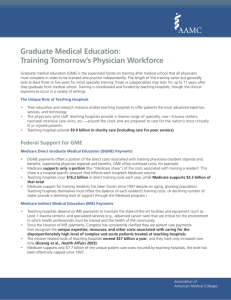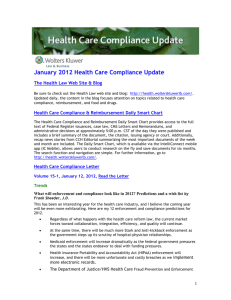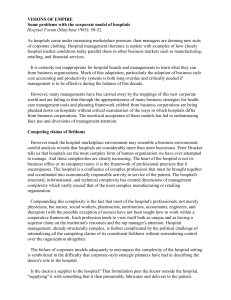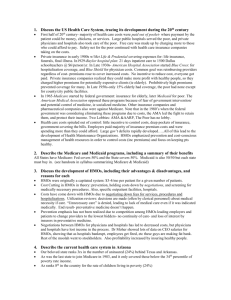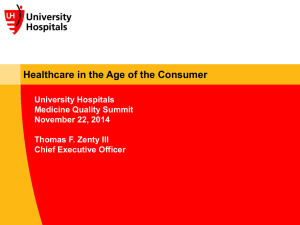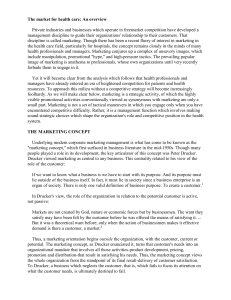Proposed Updates to the Sixth Edition of Health Care USA
advertisement
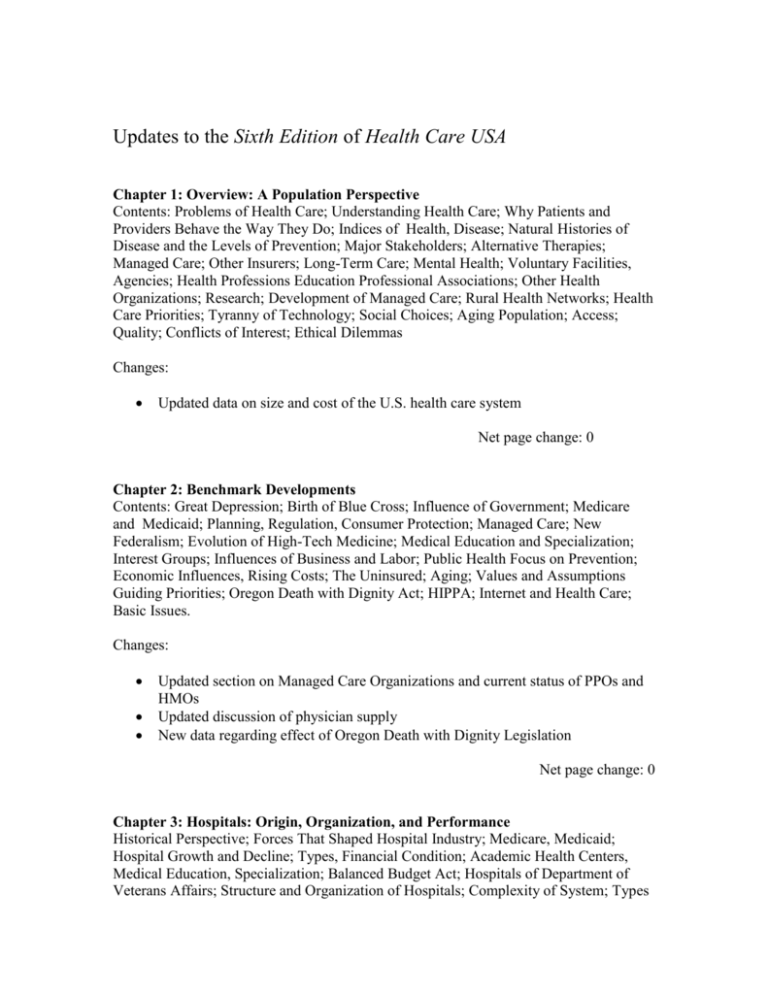
Updates to the Sixth Edition of Health Care USA Chapter 1: Overview: A Population Perspective Contents: Problems of Health Care; Understanding Health Care; Why Patients and Providers Behave the Way They Do; Indices of Health, Disease; Natural Histories of Disease and the Levels of Prevention; Major Stakeholders; Alternative Therapies; Managed Care; Other Insurers; Long-Term Care; Mental Health; Voluntary Facilities, Agencies; Health Professions Education Professional Associations; Other Health Organizations; Research; Development of Managed Care; Rural Health Networks; Health Care Priorities; Tyranny of Technology; Social Choices; Aging Population; Access; Quality; Conflicts of Interest; Ethical Dilemmas Changes: Updated data on size and cost of the U.S. health care system Net page change: 0 Chapter 2: Benchmark Developments Contents: Great Depression; Birth of Blue Cross; Influence of Government; Medicare and Medicaid; Planning, Regulation, Consumer Protection; Managed Care; New Federalism; Evolution of High-Tech Medicine; Medical Education and Specialization; Interest Groups; Influences of Business and Labor; Public Health Focus on Prevention; Economic Influences, Rising Costs; The Uninsured; Aging; Values and Assumptions Guiding Priorities; Oregon Death with Dignity Act; HIPPA; Internet and Health Care; Basic Issues. Changes: Updated section on Managed Care Organizations and current status of PPOs and HMOs Updated discussion of physician supply New data regarding effect of Oregon Death with Dignity Legislation Net page change: 0 Chapter 3: Hospitals: Origin, Organization, and Performance Historical Perspective; Forces That Shaped Hospital Industry; Medicare, Medicaid; Hospital Growth and Decline; Types, Financial Condition; Academic Health Centers, Medical Education, Specialization; Balanced Budget Act; Hospitals of Department of Veterans Affairs; Structure and Organization of Hospitals; Complexity of System; Types and Roles of Patients; Rights and Responsibilities of Patients; Important Decisions, Informed Consent, Second Opinions; Diagnosis-Related Group Hospital Reimbursement System; Discharge Planning; Subacute Care; Integrated Health Systems; Quality of Hospital Care; Landmark Studies of Quality of Hospital Care; Nurse Shortage; Forces of Reform: Cost, Quality, and Access; Changes: Updates to all data regarding number, types, and services of U.S. hospitals New discussion of the rapidly increasing number of physician-owned specialty hospitals and surgical centers and their effects on public and voluntary hospitals Updated information on the variety of efforts of hospitals to reduce medical errors, e.g. Institute for Health Care Improvement, 100,000 Lives Initiative New discussion of the new Medicare website on hospital performance standards Updated information on the efforts of hospitals to reduce hospital-transmitted infections New discussion of the community-wide over-capacity of hospital beds and underutilization costs New discussion of the advances in non-invasive technology, i.e. MRI/CT/PET in coronary artery disease diagnosis and implications for hospitals, providers and patients New information on the increasing interest in challenging tax-exempt status of hospitals providing little or no charitable care Net page change: + 2 Chapter 4: Ambulatory Care Contents: Overview and Trends; Private Medical Office Practice; Other Ambulatory Care Practitioners; Ambulatory Care Services of Hospitals: History and Trends; Hospital Emergency Services; Free Standing Services; Primary Care Centers; Urgent/Emergent Care Centers; Ambulatory Surgery Centers; Community Health Centers; Public Health Services; Voluntary Agencies; Continued Expansion Changes: Updated data on physician practice characteristics Updated information on hospital ambulatory clinics activity relative to hospital revenues New discussion of the increasing hospital competition with privately owned outpatient facilities Updated emergency department utilization data and current issues in ED capacity New discussion of the continuing proliferation of hospital and privately owned free standing emergent care centers. Updated data on freestanding surgery centers Expanded discussion of and updated data on the role of federally funded Community Health Centers as community “safety-nets.” Updated data and expanded discussion of roles of State and local health departments in emergency preparedness and epidemic control planning and management Voluntary Agencies: New discussion about the pressures for consolidation and collaboration from government and private funders to eliminate duplication of overhead and services. Net page change: 0 Chapter 5: Medical Education and the Changing Practice of Medicine Contents: Flexner Report and Medical School Reforms; Academic Medical Centers; Graduate Medical Education Consortia; Delineation and Growth of Medical Specialties; Specialty Boards and Residency Performance; Funding of Graduate Medical Education; Physician Workforce and U.S. Medical Schools; Generalist/Specialist Imbalance; Primary Care Physicians; Preventive Medicine; Changing Physician/Hospital Relationships, Cost Containment, Restructuring Medical Practice; Hold Harmless Clauses; Clinical Practice Guidelines; Physician Report Cards; Escalating costs of Malpractice Insurance; Growing Concern About Ethical Issues; Physicians and the Internet; Provider Network Contracting; Management Service Organizations; Future of Medical Practice. Changes: Updated data on the number and roles of hospitalists; new discussion about continuity of care Removed section on now defunct Physician-Hospital Organizations New section on the significant decline of physician incomes in the last decade in contrast to rising incomes of other professionals. New information about how managed care organizations undervaluing of the services of primary care physicians has led to a decline in availability of general practitioners and predictions of a dire shortage in primary care services. New remarks about how the growing concerns of serious physician shortages in near future has stimulated medical schools to increase class size. Net page change: -1 Chapter 6: Health Care Personnel Contents: Health Professions; Health Care Personnel; Health Care Reforms; Credentialing and Regulating Health Professionals; Health Care Occupations; Alternative Therapists; Factors Influencing Demand for Health Personnel; Health Care Workforce Issues; Changes: Updated Department of Labor estimates of number and types of health care personnel. Updated information on the factors that influence the demand and utilization of health care personnel with particular reference to changing hospital and managed care practices. Updated information on the influence of technological innovations on the functions of specific health care professionals. Net page change: 0 Note: Chapters 7 and 8 are now combined. The Chapter 7 title “Financing Health Care” was retained but now includes the discussion of managed care which was formerly Chapter 8. Chapter 7: Financing Health Care (includes former Chapter 8) Contents: Health Care Expenditures in Perspective; New Diagnostic and Treatment Technology; Growth of Specialized Medicine; The Uninsured and Underinsured; A Labor-Intensive Industry; Economic Incentives That Fuel Rising Costs; Components of Health Care Expenditures; Sources of Health Care Payment; Evolution of Health Insurance: Third-Party Payment; Self-Funded Insurance Programs; Government as a Source of Payment; Balanced budget Act of 1997; Other Services Funded by the Government; The Future: Continuing Change Contents: Chapter 8: Historical Perspective; Managed Care Fundamentals; HMO Act of 1973; Evolution of Managed Care; Emerging Developments in Managed Care; Medicare and Medicaid Managed Care; Managed Care Organizations and Quality; The Future of Managed Care Changes: (combining former Chapters 7 and 8:) Updated National Health Care Expenditures Data through latest available data. Updated data on the number of un-underinsured Americans with impact to costs A new historical overview of Medicare and Medicaid programs: definitions and history Updated data on the sources of payment and payment recipients New explanation of the role of Managed Care as the primary mode of US health insurance coverage New discussion of the programmatic and cost implications of the Medicare Prescription Drug Improvement and Modernization Act of 2003. Shorter discussion of the Balanced Budget Act of 1997 to just an historical perspective Updated information on current Medicare and Medicaid program expenditure data Updated trends in Medicare and Medicaid cost containment strategies Updated fiscal challenges for employers at the federal, state and local levels Updated “Consumer Driven” health insurance initiatives New discussion of government and private insurer cost savings initiatives through education and case management. . Net page change: -20 Chapter 8: Long Term Care (Former Chapter 9) Contents: Long-Term Care and the Continuum of Care; Development of Long-Term Care Services; Modes of Delivery of Long-Term Care Services; Skilled Nursing Care; Assisted Living; Hospice Care; Respite Care; Adult Day Care; Innovations in Long-Term Care; Long-Term Care Insurance; The Future of Long-Term Care. Changes: Updated long term care industry trends Updated statistics on needs, use, and costs for: o Skilled nursing care o Home Care o Assisted Living Arrangements o Hospice o Respite o Adult Day Care o Continuing Care Retirement and Long Term Care Communities Updated information on Federal Administration on Aging demonstration “Aging in Place” projects. Updated report on long term care insurance enrollments: ongoing challenges. Net page change: -3 Chapter 9: Mental Health Services (Former Chapter 10) Contents: Historical Overview; Recipients of Mental Health Services; Children and Adolescents; Older Adults; The Organization and Funding of Mental Health Services; Health Insurance Coverage and Managed Behavioral Health Care; Barriers to Accessing Services; Priorities for Mental Health Services; Need for Further Research Changes: Updated profile of affected populations New discussion of the prevalence of dementia disorders in older adults; add discussion of preventive behavioral services. New information on pharmacological advances in treatment of dementias Updated data on insurance coverage for behavioral health Updated information on implementation progress on the NIMH Plan Updated developments from the “Freedom Commission on Mental Health” initiative Net page change:0 Chapter 10: Public Health and the Role of Government in Health Care (Former Chapter 11) Contents: Historical Perspective; Public Health and Government-supported Services; Decline of the Public Health Service; Responsibilities of the Public Health Sector; Relationships of Public Health and Private Medicine; Resource Priorities Favoring Curative Medicine; Health Care Reform and the Public Health/Medicine Relationship; Hospital-Sponsored Public Health Activities; Public Health Services of Voluntary Agencies; Changing Roles of Government in Public Health; Public Health in an Era of Privatization and Managed Care; State Children’s Health Insurance Program; Federal Support to Address Emerging Health Issues; Future Role of Government in Promoting the Public’s Health. Changes: Updated budget and description of the U.S. Public Health Service Updated budget and description of services of the U.S. Veteran Administration’s Medical Centers New discussion of the effect of influx of Iraq War casualties on VA services. Update federal, state and local public health initiatives in emergency preparedness for terrorist activities and avian influenza Net page change: 0 Chapter 11: Research: How Health Care Advances (Former Chapter 12) Contents: The Focus of Different Types of Research; Research in Health and Disease; Epidemiology; Health Services Research; Agency for Health Care Policy and Research; Health Services Research and Health Policy; Quality Improvement; Medical Errors; Evidence-Based Medicine; Outcomes Research; Patient Satisfaction; Research Ethics; Future Challenges Changes: Revise section on “Research Ethics” to reflect growing concerns about financial ties between pharmaceutical companies and supposedly “independent” researchers who judge the safety and effectiveness of newly developed drugs. Update section on Federal Drug Administration to reflect latest administrative and performance activities. Net page change: 0 Chapter 12: The Future of Health Care (Former Chapter 13) Contents: The Paradox of U.S. Health Care; Major Challenges; Growing Number of Uninsured; Demand for Greater Accountability; Technological Growth and Innovation; Changing Population Composition; New Physician Roles; Academic Health Centers; Health Professions; Nurses, Nurse Practitioners; Physician Assistants; Increased Scrutiny of Costs; New Health Insurance Plan; Changing Composition of Health System; Corporate Growth in Health Care; Corporate Alliances; Information Management; Future Role of the Federal Government; Conclusion Changes New remarks on the increasing number and changing characteristics of Americans without health insurance Condensed section on “Demand for Greater Accountability.” Updated discussion of future supply and roles of physicians, nurses, physician assistants and nurse practitioners. Updated and condensed sections on “Corporate Growth” and “Corporate Alliances” in health care. Condensed “Conclusion” section of this chapter. Net page change: -3

